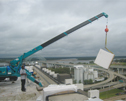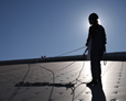NRCA's Technical Services Section has received a limited number of reports of moisture accumulation in relatively new, highly reflective roof assemblies. Although the specific circumstances vary somewhat, a commonality is that the roof assemblies consist of nonadhered roof coverings usually over a single layer of high R-value insulation. The reported problems have occurred in relatively hot, dry climates, such as the Southwest, as well as cool, damp climates, such as northern portions of the Midwest.
There are likely causes of such moisture accumulation, and NRCA has some recommendations for minimizing or eliminating this phenomenon.
Self-drying roofs
Experience and limited research have shown that nonadhered membrane roof systems with highly reflective surfaces are more susceptible to moisture accumulation than roof systems without highly reflective surfaces. This phenomenon is most pronounced in roof systems with single layers of rigid board insulation, which results in "thermal shorts" at board joints and mechanical fasteners that penetrate through a roof system's thickness.
A roof system designed without a properly placed vapor retarder within the roof assembly's cross-section likely functions as a "self-drying" roof assembly. That is, it will accumulate small amounts of moisture generated from inside the building when vapor flows from the building's interior to its exterior. This usually occurs when the outside temperature is cooler than the interior temperature.
In a self-drying roof assembly, accumulated moisture in the roof assembly gradually will be released, or "dry down," toward the building's interior when vapor flows from the building's exterior to its interior. This typically occurs when the outside temperature is warmer than the interior temperature.
A self-drying roof assembly performs successfully when its moisture dry down offsets its accumulation during the long term. In situations where a roof system has a highly reflective surface, the roof's surface and other layers will be somewhat cooler than similar roof systems without highly reflective surfaces. As a result, roof systems with highly reflective surfaces will not dry down as quickly or to the same extent as roof systems without highly reflective surfaces.
The correlation of the reported problems to single-layer, high R-value insulation appears significant because it provides for board joints that extend through a roof system's cross-section, resulting in an overall loss of thermal efficiency and air and moisture vapor movement within the roof assembly. Research has shown board joints from a single-layer insulation design can reduce thermal efficiency up to 10 percent compared with using multiple insulation layers of an equivalent overall R-value.
NRCA's recommendations
Based on years of satisfactory performance in the U.S., NRCA considers the self-drying roof assembly concept to be technically viable. However, for roof assemblies with highly reflective surfaces, proven additional design considerations that are consistent with NRCA's best-practice guidelines should be implemented.
NRCA recommends roof system designers use a minimum of two layers of insulation in low-slope roof system designs and the two layers be installed with offset joints to minimize air leakage and movement and thermal shorts.
NRCA also suggests roof system designers consider using properly placed vapor retarders as components of roof systems with highly reflective roof surfaces.
Additional information about reducing moisture accumulation in low- and steep-slope roof systems is contained in the Condensation Control section of The NRCA Roofing Manual: Architectural Metal Flashing, Condensation Control and Reroofing—2010.
Mark S. Graham is NRCA's associate executive director of technical services.



